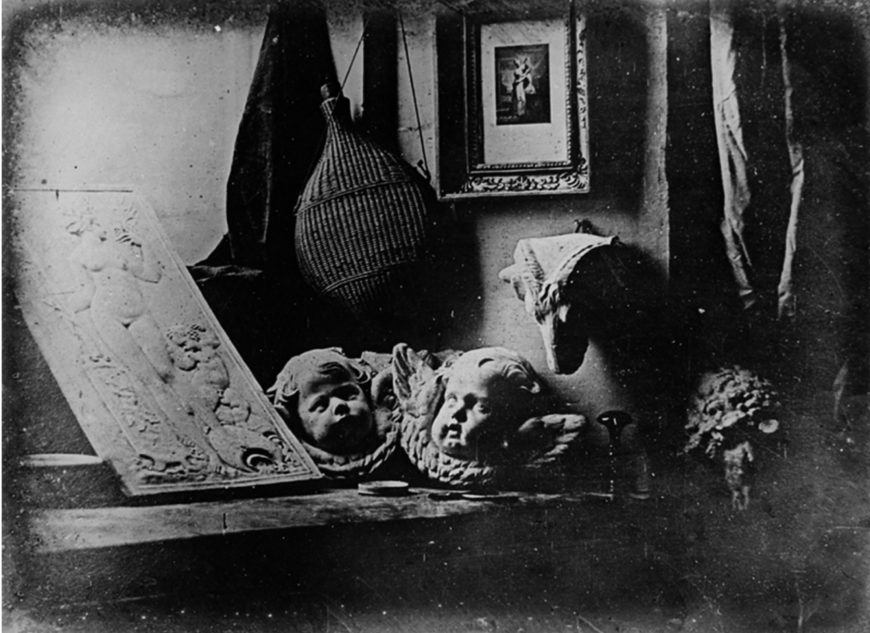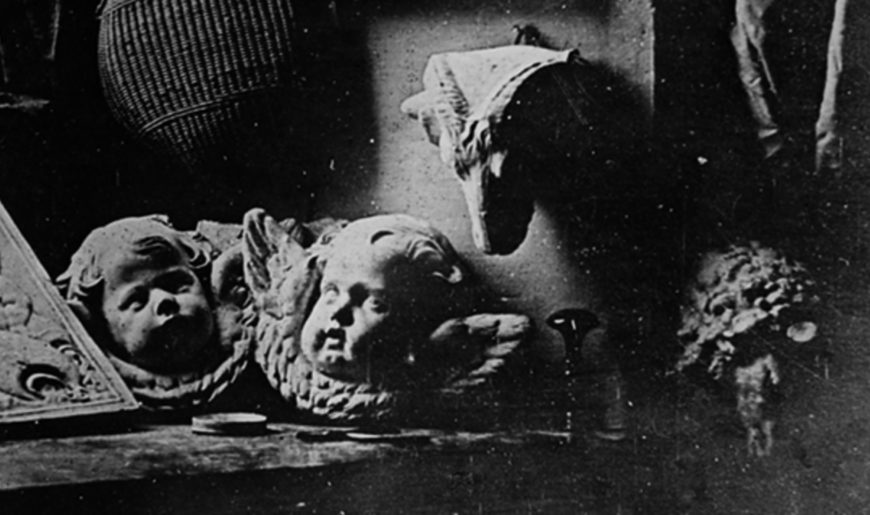
Louis-Jacques-Mandé Daguerre, The Artist’s Studio / Still Life with Plaster Casts, 1837, daguerreotype (photography), 6.5 inches by 8.5 inches (public domain)
Louis-Jacques-Mandé Daguerre’s oldest surviving photograph (which predates the announcement of the invention of the medium in 1839 by two years), The Artist’s Studio / Still Life with Plaster Casts, was made using his modestly self-named “daguerreotype” process. One-of-a-kind images like these offer sharp details on small, mirrored, silver-coated copper plates. This is one of only about 25 of Daguerre’s images to survive.
Like many of the founding inventors of photography, Daguerre—a Parisian theatrical scene-painter/designer and showman—saw this new medium as part-art, part-science. This image of Daguerre’s own studio (he was a practicing artist), testifies to photography’s scientific achievement (resulting from incessant experiments with photochemistry, partly to find a way to make a permanent image) as it also implicitly argues for photography’s merit as an art medium by providing a link between photography and a traditional still-life painting.
Making an argument for photography as an art medium
The still life is a genre of subjects in artworks that involves inanimate objects, arranged to evoke symbolic associations. The subjects of The Artist’s Studio / Still Life with Plaster Casts lend themselves to visual analysis using the elements of art and principles of composition. Framed by drapery in the corner of his studio, a wicker-covered bottle hangs near a framed artwork just above the center of the frame, both surrounded by plaster casts of the heads and tiny wings of two putti (center), the head of a ram (center-right), and a panel bearing a nude female (possibly Venus) in low relief, flanked by a pushy Cupid (left edge).
Daguerre’s combination of objects obediently remained still for the duration of the long exposure (an estimated 15–20 minutes), but also displayed a remarkably wide range of tonal values, variegated textures, highlights, and shadows to add visual interest. Vertical architectural framing is offset by compositional diagonals to move the viewer’s eye dynamically through the image. In other words, Daguerre did not set up and make this photograph solely to test his photochemistry, but to accentuate the artistic value of his subject matter—and by extension, to highlight the artistic value of the new medium he helped create.
His efforts were successful. Early reviews of Daguerre’s photographic experiments in the Paris press enthusiastically lauded the artful nature of these new pictures. One anonymous writer excitedly claimed: “Every picture that was shown us produced an exclamation of admiration. What fineness in the strokes! What knowledge of chiaroscuro! What delicacy! . . . How admirably are the foreshortenings given: this is Nature itself. All this is wonderful.” [1]
Daguerre so wholeheartedly also wanted the approval of the art world that the back side of The Artist’s Studio / Still Life with Plaster Casts reveals a hand-written inscription to Alphonse de Cailleux, who in 1836 became the Director of the Musée du Louvre, and the recipient of this image in 1839. Translated, the inscription reads: “a ‘proof’ serving to verify the discovery of Daguerreotype, offered to M. de Callieux by his very devoted servant Daguerre.” Despite Daguerre’s coaxing, the French Academy of Fine Arts (the most important “tastemaker” in visual art in Paris in the 1830s) did not accept photography into its Salons. Most museums would not show photography—framed as an “art” form—until the twentieth century.

Joseph Nicéphore Niépce, View from the Window at Gras (1826)
However, Daguerre was not the first photographer to invent a lasting photochemical image of the physical world. His former partner, Joseph Nicéphore Niépce, made the image View from the Window at Le Gras 11 years earlier. Nor was Daguerre the only early practitioner to choose the still life images of plaster statuary as his subject. As photography historian Geoffrey Batchen has noted, Hippolyte Bayard, Armand-Hippolyte-Louis Fizeau, François-Alphonse Fortier, Alphonse-Eugène Hubert, Baron Armand-Pierre Séguier, and William Henry Fox Talbot all photographed copies of sculptures. [2] Statues were trendy and affordable among the European artistic/intellectual and upper-class circles from which the earliest pioneering photographers came. [3] During the 1830s, limited-edition prints also were popular with this crowd (for instance, Daumier’s Nadar Elevating Photography to the Height of an Art relates to the the mass visual culture of 1830s Paris).
Still life: old symbolism meets a new medium
As subjects, Daguerre’s chosen still-life subjects also held symbolic potency that acknowledges the making of photographs.

Louis-Jacques-Mandé Daguerre, The Artist’s Studio / Still Life with Plaster Casts (detail), 1837, daguerreotype (photography), 6.5 inches by 8.5 inches (public domain)
For example, putti were associated with Phaëthon, son of Helios, the Greek god of light. [4] Here, Daguerre recognizes and celebrates light—the essential natural agent of photography (which literally translates to “light writing”). As a recurring subject of art that first emerged in ancient Greece and Rome, putti also appeared in Pompeii wall paintings, and in art during the Renaissance, Baroque, and Rococo periods. [5]
The ram’s-head statue (center-right) in The Artist’s Studio / Still Life with Plaster Casts also gives a nod to the sun, a source of light for making early photographs, while also subtly drawing attention to the importance of the light-absorptive surface itself. The Golden Ram (the source of the Golden Fleece) in ancient Greek mythology was descended from the sun god Helios. Some scholars have argued that the ram’s fleece itself symbolized the sun reflected in the seas. [6] In that manner, the reflective, metallic Golden Fleece is analogous to the daguerreotype—both of which had reflective surfaces that also absorb the sun’s traces of light.
Daguerre’s The Artist’s Studio / Still Life with Plaster Casts simultaneously shows off his new medium’s promise as an art form by adopting the still-life genre, integrating common tropes such as putti, evoking references to light and the Sun, and inviting viewers to appreciate his subjects through visual analysis using the elements and principles of art and design. It would take until the twentieth century for photography to slowly find acceptance as “art,” even if Daguerre foresaw its merits right away. [7]

